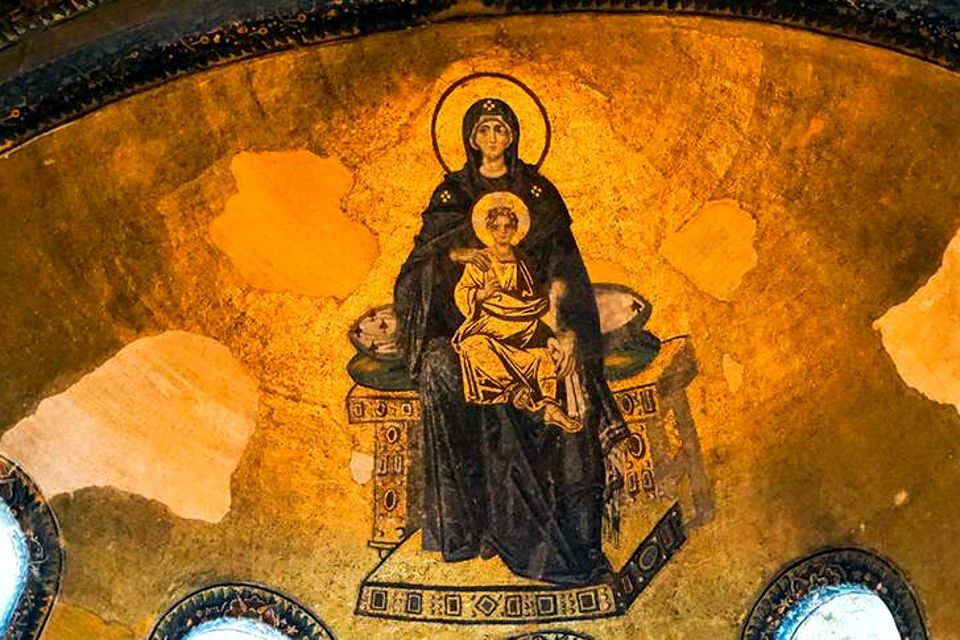
Mary in Istanbul
The conferences I had to attend overseas allowed me to experience Turkish Air and touchdowns in Istanbul a number of times. Twice, I also managed to avail free layover service. Everyone who flew through Istanbul and had a 6-24 hours layover time was eligible for a tour with an itinerary of our choosing, gratis. The choice, of course, was not difficult for me to make; it had to be one that included a visit to the Hagia Sophia.
The Hagia Sophia, constructed in 537, was the patriarchal cathedral of the imperial capital of Constantinople. It was the largest Christian church of the eastern Roman Empire (the Byzantine Empire) and the Eastern Orthodox Church, except from 1204 to 1261, when it became the Latin Catholic cathedral of the city. In 1453, after the Fall of Constantinople to the Ottoman Empire, the church was converted into a mosque. In 1935, the secular Turkish Republic established it as a museum. In 2020, it controversially re-opened as a mosque.
The Hagia Sophia was the center of religious, political, and artistic life for the Byzantine world. Thus, it has the most well-preserved mosaics of the period, thanks to Ottoman iconoclasts who earlier covered its walls and ceilings with plaster, which inadvertently served to protect and preserve the multi-colored tesserae of these splendid mosaics.
One of the mosaics was the reason for my interest in the Hagia Sophia: the Theotokos, an image of the Virgin Mary with the Child Christ seated on her lap. One sees this located on what may be the most visible spot on the ceiling, up until it was curtained in 2020 by the current Turkish administration.
Theotokos is Greek for “Mother of God,” the oldest formal title ever bestowed to the Virgin Mary. Mary, indeed, holds a special place in the Catholic imagination because she was the one who bore Christ, brought Him into the world, and nurtured Him.
The image also bespeaks though of the name of this splendid architectural marvel, for it follows that being Theotokos, Mary was also Sedes Sapientiae, the Seat of Wisdom. In Turkish, the Hagia Sophia.
When Jesus Christ, who is the Second Person of the Blessed Trinity, the Eternal Wisdom of the Father, took up His dwelling in Mary, He made her His Temple and became Man. As a Child seated on the knee of His mother, she was, in literal truth, His throne and temple. We, too, each one of us, are temples of Wisdom, “temples of the Holy Spirit,” as St. Paul says. And whenever we receive Holy Communion, we likewise become the throne or temple of Our Lord in a most real, physical way.
Such an overflowing of Grace may take place in each occurrence or contact, subject of course to how the temple or receptacle has been cleansed and prepared to be worthy of reception. Mary, who was full of grace, was most worthy and was in fact chosen by God Himself to be His abode for nine months.
Indeed, if a Christian desires Wisdom, one must sit at Mary’s feet as Christ himself did. Through Mary, we always go to Jesus.
“His throne, thy bosom blest,
O Mother undefiled.
That Throne, if aught beneath the skies,
Beseems the sinless Child.”
(Saint John Cardinal Newman, The Mystical Rose)
Sancta Maria, spes nostra, sedes Sapientiae, ora pro nobis!
Holy Mary, our hope, Seat of Wisdom, pray for us!
(Honey Libertine Achanzar-Labor, PhD)


No Comments